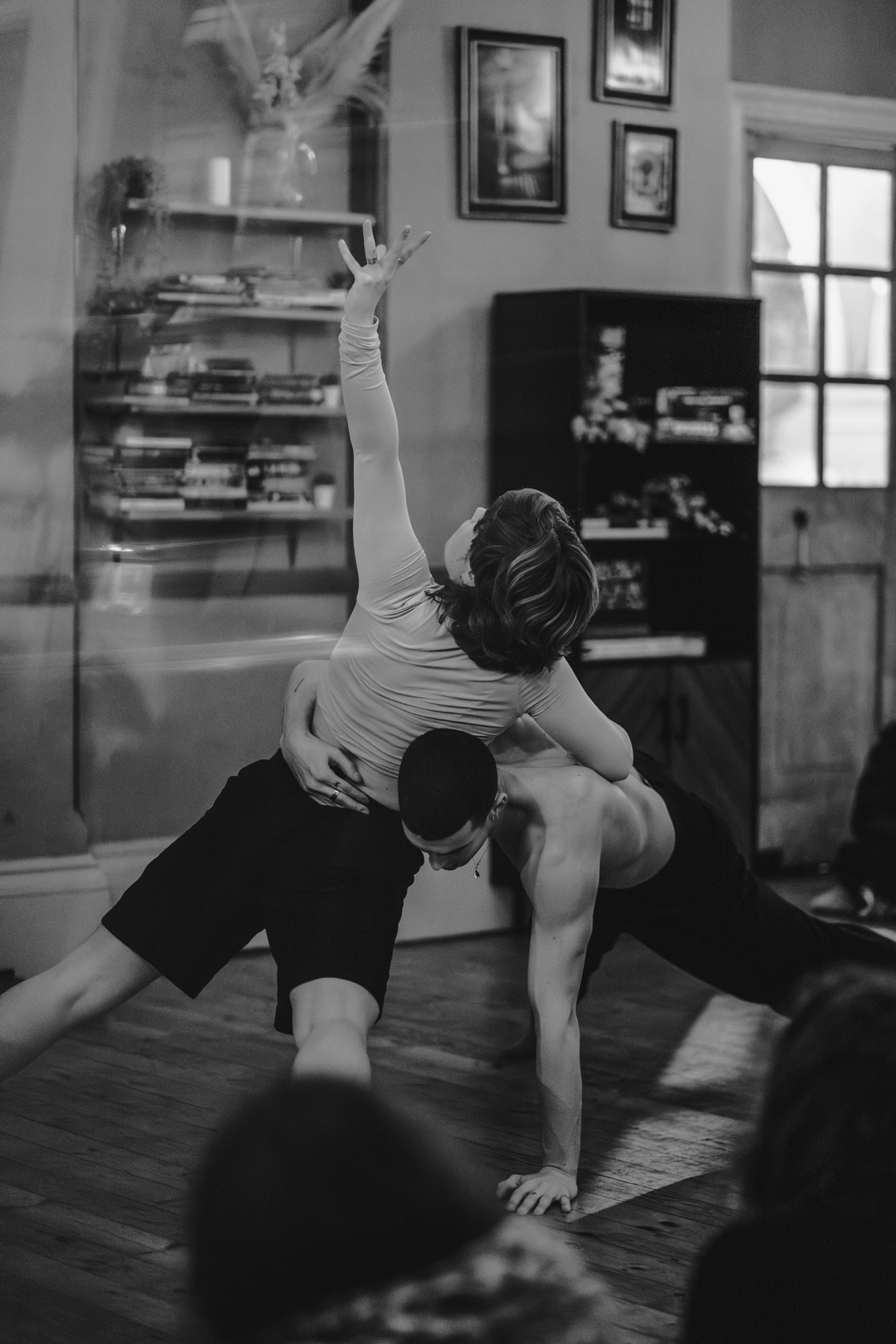Words by Stephanie Burrell.
Manon Servage and collaborator/dancer Zach Parkin’s A Regarder les Etoiles is a poetic and embodied meditation on mortality, grief and our complex relationship with it. It was staged as part of Sofar London, new dance sessions taking place around the city.
This contemporary dance ebbs and flows between technical precision and a breathability that creates a space for any type of art-lover and or audience-member to reflect and process.
The use of space is really important to this work and so I’d like to begin my reflections there. A Regarder les Etoiles has the key factors to be recontextualised for any audience or space. A reflexive and esoteric experience in Battersea Arts Centre’s intimate informal bar space; Servage and Parkin were almost non-verbal facilitators. They held the space and created a chamber of care for introspection on our own mortality and for those who have passed. As described in the programme notes: A Regarder les Etoiles is certainly a poetic meditation, constructing space for the silent dialogues we hold with death, blending sorrow with reverence.
Servage has created a work that can mould into and dissolve into any space with ease, even down to the choice of using neutral-colour skin-tight costumes. Though you wouldn’t normally find technical contemporary dance in the bar at Battersea Arts Centre, there is an ease and breathability to the piece that allows it to land. Servage as Artistic Director, Creator and Producer has cleverly chosen the music as a score to accompany the piece rather than dictate it. This element complemented the staging in the bar area. The contemporary classical score was a sonic invitation for the performers and audience to grow more intimate and take comfort in a close performance-proximity foreign to those who only frequent spaces such as Sadler’s Wells. The dancer’s breath was the symphony giving audible life to the space – in parlance with the audience. Breath became the real metronome for keeping the pace of the piece. Servage emphasised something so universal; an involuntary vital process made viscerally audible. It allowed any audience member to engage with the themes of grief and mortality at the heart of the piece.
A Regarder les Etoiles’ relationship to spatiality is dynamic and symbiotic; the piece has potential to transform any space into a stage and let any scenery mark the work. The virtuosic extensions and post-human balances also deserve sacrosanct renowned stages. The piece teases with technical dance-motifs that wet the appetite to see the duet on an arena-scale. It has an operatic spectacle quality.
Onto the movement and choreography, release and softness was in-conversation with extreme tension, somatic force and balletic precision. These moments where Servage allowed their technical training to shine were moments of clear abstraction, though seemingly an oxymoron; Servage pinpoints lines and dynamism with divine timing. Arabesques and precise tendus were guiding forces; directing the audiences’ gaze, ways of seeing and feeling.
Parkin’s pedestrian yet poignant move, where he covers Servage’s eyes, is a motif woven throughout the piece. An accessible symbol that encapsulates its premise; to explore our nuanced perceptions around the moment where the physical body leaves the world and what happens after. This narrative symbol is quite literally sliced by Servage’s virtuosic elongated penché; a balletic movement supported in pas-de-deux with Parkin. Servage fuses universal semiotics; the palm obscuring sight with the heightened drama of the ballet.
This hybrid of accessible sign-making and melodic athleticism is performance art on cartesian theory and mind-body relationship. Descartes’ mind-body dualism posits the mind and body are separate substances. Manon’s artistry both affirms and contradicts this. Servage plays with role substitution. Parkin and Servage take turns obscuring the sight of their fellow dancer withthe singular palm. This action is memorable, effective and poetic. Parkin lies on the floor in an almost-fetal yet bug-like position with his legs in the air. As his legs drift with elegance, strength but also struggle, Servage guides and maneuvers him across the floor – mapping out the floor of Battersea Arts Centre via the vertebrae. Again with the central symbol – the palm over the eyes. The choreographic choice to sweep the floor of BAC bar via Parkin’s epidermis requires such intimacy and trust between the dancers. This affirms that mind-bodies are in dialogue with one another and this reaches an apex when seen on two bodies working in-tandem.
Yet, Servage also lets the audience feast on the powerful technical skillset they both possess. The two rising talents within the dance landscape of London and beyond quite literally flex that the body is a powerhouse system in of itself. Without hesitation, the dancers drop the mind-body dualism floorwork and shoot out from the floor. In a flash, they bolt into a compact contemporary-ballet reminiscent of Mcgregor’s ‘Chroma’ for the Royal Opera House (2006). Extreme lines and spinal contortions, which dangle Servage centimetre from the floor, are testaments to training, discipline and body mechanics. A Regarder les Etoiles transforms into a call to pay reverence to the material body whilst we can.
Breath, technical prowess and vulnerability charge the piece with a universally accessible energy. An energy that emboldens the viewer to soften and reflect whilst simultaneously meditating on grander questions of mortality, loss and transcendence.
